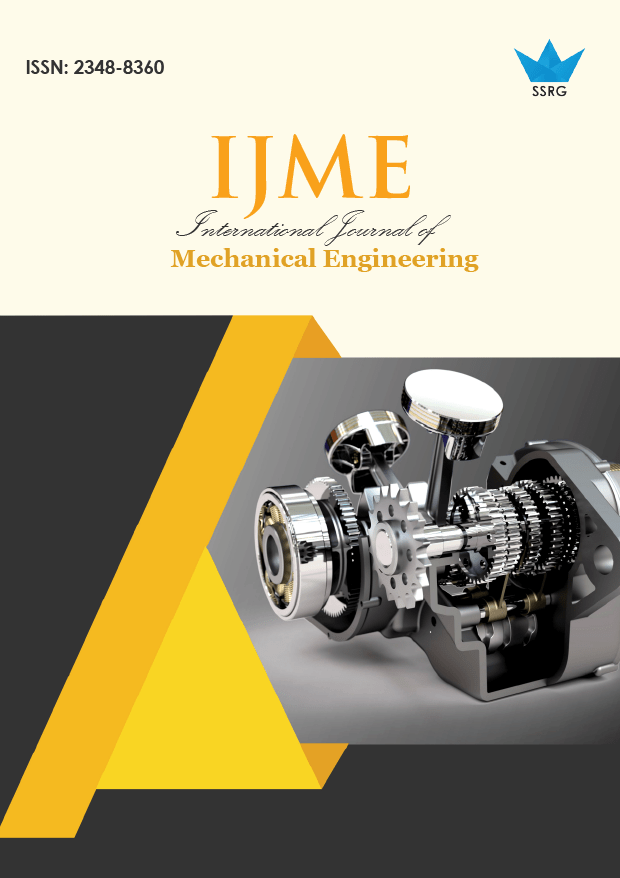Enhancing Sustainable VCR Engine Operation Using Mahua Oil Methyl Ester with Thermal Barrier Coating

| International Journal of Mechanical Engineering |
| © 2025 by SSRG - IJME Journal |
| Volume 12 Issue 10 |
| Year of Publication : 2025 |
| Authors : Gopal Radhakrishnan Kannan |
How to Cite?
Gopal Radhakrishnan Kannan, "Enhancing Sustainable VCR Engine Operation Using Mahua Oil Methyl Ester with Thermal Barrier Coating," SSRG International Journal of Mechanical Engineering, vol. 12, no. 10, pp. 1-9, 2025. Crossref, https://doi.org/10.14445/23488360/IJME-V12I10P101
Abstract:
In order to lower hazardous emissions and improve the diesel engine characteristics, there has been a recent push for appropriate alternative fuels and improved performance tactics. In order to analyze the diesel engine behavior with variable compression ratios, the combined effect of alternate fuel and thermal barrier-coated engine crown was studied. Using Mahua Oil Methyl Esters (MOME) with various Compression Ratios (CR) ranging from 17:1, 19:1, and 21:1 at various load circumstances, the performance, emission, and combustion characteristics of the thermal barrier-coated VCR engine were examined and contrasted with those of diesel and non-coated or standard engines. Based on observed results, the adiabatic engine with a higher compression ratio of 21 (CR21-AE-B100) demonstrated the following characteristics: a higher cylinder gas pressure of 61.7 bar, a higher heat release rate of 78.6 J/oCA, a shorter ignition delay period of 9.8 oCA, a maximum brake thermal efficiency of 28.12%, the lowest Brake Specific Fuel Consumption (BSFC) of 0.3423 kg/kW h, a maximum Nitric Oxide (NO) emission of 575 ppm, and lowest smoke opacity of 37.8%.
Keywords:
Adiabatic coating, Bond coat, Top coat, Combustion and emission, Mahua oil methyl ester, Performance.
References:
[1] Frederica Perera, “Pollution from Fossil-Fuel Combustion is the Leading Environmental Threat to Global Pediatric Health and Equity: Solutions Exist,” International Journal of Environmental Research and Public Health, vo. 15, no. 1, pp. 1-16, 2018. [CrossRef] [Google Scholar] [Publisher Link]
[2] N.I.T.I. Aayog, “Rocky Mountain Institute 2018 Goods on the Move: Efficiency & Sustainability in Indian Logistics,” Technical Report, 2018.
[Google Scholar]
[3] “Renewables 2019 Global Status Report,” pp. 1-336, 2019.
[Google Scholar] [Publisher Link]
[4] S. Kerschbaum, and G. Rinke, “Measurement of the Temperature Dependent Viscosity of Biodiesel Fuels,” Fuel, vol. 83, no. 3, pp. 287-291, 2004.
[CrossRef] [Google Scholar] [Publisher Link]
[5] S.N. Naik et al., “Production of First and Second Generation Biofuels: A Comprehensive Review,” Renewable & Sustainable Energy Reviews, vol. 14, no. 2, pp. 578-597, 2010.
[CrossRef] [Google Scholar] [Publisher Link]
[6] Alison Mohr, and Sujatha Raman, “Lessons from First Generation Biofuels and Implications for the Sustainability Appraisal of Second Generation Biofuels,” Energy Policy, vol. 63, pp. 114-122, 2013.
[CrossRef] [Google Scholar] [Publisher Link]
[7] R. Piloto-Rodríguez et al., “Conversion of by-Products from the Vegetable Oil Industry into Biodiesel and its Use in Internal Combustion Engines: A Review,” Brazilian Journal of Chemical Engineering, vol. 31, no. 2, pp. 287-301, 2014.
[CrossRef] [Google Scholar] [Publisher Link]
[8] Ayyasamy Tamilvanan et al., “Effect of Diethyl Ether and Ethanol as an Oxygenated Additive on Calophyllum Inophyllum Biodiesel in CI Engine,” Environmental Science and Pollution Research, vol. 28, pp. 33880-33898, 2021.
[CrossRef] [Google Scholar] [Publisher Link]
[9] K. Nanthagopal, B. Ashok, and R. Thundil Karuppa Raj, “Influence of Fuel Injection Pressures on Calophyllum Inophyllum Methyl Ester Fuelled Direct Injection Diesel Engine,” Energy Conversion and Management, vol. 116, pp. 165-173, 2016.
[CrossRef] [Google Scholar] [Publisher Link]
[10] B. Ashok et al., “Calibration of Idling Characteristics for Lemon Peel Oil Using Central Composite Design in Light Commercial Vehicle Diesel Engine,” Energy Conversion and Management, vol. 221, 2020.
[CrossRef] [Google Scholar] [Publisher Link]
[11] A.M. Ashraful et al., “Production and Comparison of Fuel Properties, Engine Performance, and Emission Characteristics of Biodiesel from Various Non-Edible Vegetable Oils: A Review,” Energy Conversion and Management, vol. 80, pp. 202-228, 2014.
[CrossRef] [Google Scholar] [Publisher Link]
[12] Selman Aydin, Cenk Sayin, and Hüseyin Aydin, “Investigation of the Usability of Biodiesel Obtained from Residual Frying Oil in a Diesel Engine with Thermal Barrier Coating,” Applied Thermal Engineering, vol. 80, pp. 212-219, 2015.
[CrossRef] [Google Scholar] [Publisher Link]
[13] A.K. Agarwal, J. Bijwe, and L.M. Das, “Effect of Biodiesel Utilization of Wear of Vital Parts in Compression Ignition Engine,” Journal of Engineering for Gas Turbines and Power, vol. 125, no. 2, pp. 604-611, 2003.
[CrossRef] [Google Scholar] [Publisher Link]
[14] Sharad P. Jagtap, Anand N. Pawar, and Subhash Lahane, “Improving the Usability of Biodiesel Blend in Low Heat Rejection Diesel Engine through Combustion, Performance and Emission Analysis,” Renewable Energy, vol. 155, pp. 628-644, 2020.
[CrossRef] [Google Scholar] [Publisher Link]
[15] V. Karthickeyan et al., “Experimental Investigation of Pomegranate Oil Methyl Ester in Ceramic Coated Engine at Different Operating Condition in Direct Injection Diesel Engine with Energy and Exergy Analysis,” Energy Conversion and Management, vol. 205, 2020.
[CrossRef] [Google Scholar] [Publisher Link]
[16] Karthickeyan Viswanathan, B. Ashok, and Arivalagan Pugazhendhi, “Comprehensive Study of Engine Characteristics of Novel Biodiesel from Curry Leaf (Murraya Koenigii) Oil in Ceramic Layered Diesel Engine,” Fuel, vol. 280, 2020.
[CrossRef] [Google Scholar] [Publisher Link]
[17] V. Karthickeyan, “Effect of Cetane Enhancer on Moringa Oleifera Biodiesel in a Thermal Coated Direct Injection Diesel Engine,” Fuel, vol. 235, pp. 538-550, 2019.
[CrossRef] [Google Scholar] [Publisher Link]
[18] Uğur Öztürk, Hanbey Hazar, and Fikret Yılmaz, “Comparative Performance and Emission Characteristics of Peanut Seed Oil Methyl Ester (PSME) on a Thermal Isolated Diesel Engine,” Energy, vol. 167, pp. 260-268, 2019.
[CrossRef] [Google Scholar] [Publisher Link]
[19] S. Mohamed Abbas, and A. Elayaperumal, “Experimental Investigation on the Effect of Ceramic Coating on Engine Performance and Emission Characteristics for Cleaner Production,” Journal of Cleaner Production, vol. 214, pp. 506-513, 2019.
[CrossRef] [Google Scholar] [Publisher Link]
[20] I.T. Yilmaz, and M. Gumus, “Investigation of the Effect of Biogas on Combustion and Emissions of TBC Diesel Engine,” Fuel, vol. 188, pp. 69-78, 2017.
[CrossRef] [Google Scholar] [Publisher Link]
[21] Selman Aydın, and Cenk Sayın, “Impact of Thermal Barrier Coating Application on the Combustion, Performance and Emissions of a Diesel Engine Fueled with Waste Cooking Oil Biodiesel–Diesel Blends,” Fuel, vol. 136, pp. 334-340, 2014.
[CrossRef] [Google Scholar] [Publisher Link]
[22] Ekrem Buyukkaya, and Muhammet Cerit, “Experimental Study of NOx Emissions and Injection Timing of a Low Heat Rejection Diesel Engine,” International Journal of Thermal Sciences, vol. 47, no. 8, pp. 1096-1106, 2008.
[CrossRef] [Google Scholar] [Publisher Link]
[23] Adnan Parlak, “The Effect of Heat Transfer on Performance of the Diesel Cycle and Exergy of the Exhaust Gas Stream in a LHR Diesel Engine at the Optimum Injection Timing,” Energy Conversion Management, vol. 46, no. 2, pp. 167-179, 2005.
[CrossRef] [Google Scholar] [Publisher Link]
[24] Sukumar Puhan, “Mahua oil (Madhuca Indica Seed Oil) Methyl Ester as Biodiesel-Preparation and Emission Characterstics,” Biomass and Bioenergy, vol. 28, no. 1, pp. 87-93, 2005.
[CrossRef] [Google Scholar] [Publisher Link]
[25] N. Saravanan, G. Nagarajan, and Sukumar Puhan, “Experimental Investigation on a DI Diesel Engine Fuelled with Madhuca Indica Ester and Diesel Blend,” Biomass and Bioenergy, vol. 34, no. 6, pp. 838-843, 2010.
[CrossRef] [Google Scholar] [Publisher Link]
[26] H.R. Amriya Tasneem et al., “Ceramic Material for Thermal Barrier Coatings in Compression Ignition Engine for its Performance Evaluation with Biodiesel,” Materials Today: Proceedings, vol. 46, no. 17, pp. 7745-7751, 2021.
[CrossRef] [Google Scholar] [Publisher Link]
[27] P.K. Devan, and N.V. Mahalakshmi, “Performance, Emission and Combustion Characteristics of Poon Oil and its Diesel Blends in a DI Diesel Engine,” Fuel, vol. 88, no. 5, pp. 861-867, 2009.
[CrossRef] [Google Scholar] [Publisher Link]
[28] J. Narayana Reddy, and A. Ramesh, “Parametric Studies for Improving the Performance of a Jatropha Oil-Fuelled Compression Ignition Engine,” Renewable Energy, vol. 31, no. 12, pp. 1994-2016, 2006.
[CrossRef] [Google Scholar] [Publisher Link]
[29] S. Bari, C.W. Yu, and T.H. Lim, “Effect of Fuel Injection Timing with Waste Cooking Oil as a Fuel in a Direct Injection Diesel Engine,” Proceedings of the Institution of Mechanical Engineers, Part D. Journal of Automobile Engineering, vol. 218, no. 1, pp. 93-104, 2004.
[CrossRef] [Google Scholar] [Publisher Link]
[30] İsmet Çelikten, Atilla Koca, and Mehmet Ali Arslan, “Comparison of Performance and Emissions of Diesel Fuel, Rapeseed and Soybean Oil Methyl Esters Injected at Different Pressures,” Renewable Energy, vol. 35, no. 4, pp. 814-820, 2010. [CrossRef] [Google Scholar] [Publisher Link]
[31] V. Arul Mozhi Selvan, R.B. Anand, and M. Udayakumar, “Combustion Characteristics of Diesohol Using Biodiesel as an Additive in a Direct Injection Compression Ignition Engine under Various Compression Ratios,” Energy & Fuels, vol. 23, no. 11, pp. 5413-5422, 2009.
[CrossRef] [Google Scholar] [Publisher Link]
[32] O.D. Hebbal, K. Vijayakumar Reddy, and K. Rajagopal, “Performance Characteristics of a Diesel Engine with Deccan Hemp Oil,” Fuel, vol. 85, no. 14-15, pp. 2187-2194, 2006.
[CrossRef] [Google Scholar] [Publisher Link]

 10.14445/23488360/IJME-V12I10P101
10.14445/23488360/IJME-V12I10P101